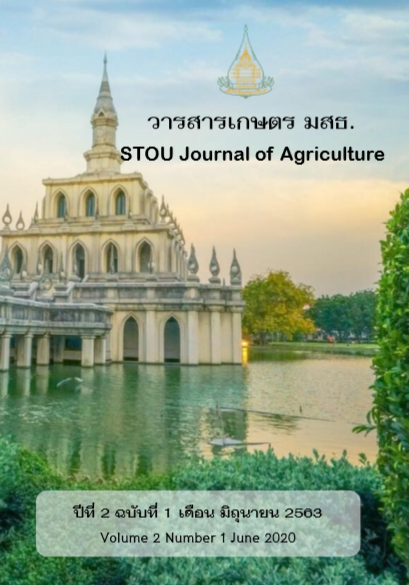สารเคมีในการผลิตพืช
Main Article Content
บทคัดย่อ
ในกระบวนการผลิตพืช เริ่มตั้งแต่การเตรียมดิน การเตรียมเมล็ดพันธุ์หรือท่อนพันธุ์ การปลูก และดูแลรักษา จนกระทั่งถึงการเก็บเกี่ยวผลผลิต และการจัดการผลผลิตหลังจากเก็บเกี่ยวมาแล้ว มีการใช้สารเคมีมากมาย ซึ่งสารเคมีเหล่านี้มีวัตถุประสงค์ในการใช้ที่แตกต่างกัน สารเคมีบางชนิดมีความจำเป็นต้องใช้ เพราะไม่มีวิธีอื่นที่สามารถทดแทนได้ ทั้งนี้เพราะผลผลิตที่มีปริมาณมากและมีคุณภาพดีย่อมเป็นที่ต้องการของตลาดและผู้บริโภค การเตรียมดินมีการใช้สารเคมีเพื่อปรับสมบัติทางเคมีของดิน การเตรียมเมล็ดพันธุ์หรือท่อนพันธุ์มีการใช้สารเคมีเพื่อป้องกันกำจัดศัตรูพืชที่ติดมากับเมล็ดหรือท่อนพันธุ์ และเพื่อทำลายการพักตัวของเมล็ด การปลูกมีการใช้สารเคมีเพื่อป้องกันกำจัดศัตรูพืช สารควบคุมการเจริญเติบโตของพืช ทั้งการเร่งการเกิดราก เพิ่มจำนวนดอก เปลี่ยนเพศดอก เพิ่มจำนวนและขนาดของผล ป้องกันการร่วงของผล ยืดความยาวช่อ ชะลอการออกดอก เพิ่มความต้านทานสภาพแวดล้อมที่ไม่เหมาะสม และยับยั้งการเจริญเติบโต ส่วนการเก็บเกี่ยวผลผลิตมีสารเคมีที่ช่วยยืดระยะเวลาเก็บเกี่ยว ชะลอการสุก ยืดอายุการเก็บรักษา เพื่อให้ผลผลิตยังคงสภาพดี ดังนั้น การใช้สารเคมีในการผลิตพืชจึงควรตระหนักถึงการใช้ให้ถูกวัตถุประสงค์ ถูกอัตรา และถูกเวลา เพื่อความปลอดภัยของเกษตรกร ผู้บริโภค และสิ่งแวดล้อม
Article Details
บทความที่ได้รับการตีพิมพ์เป็นลิขสิทธฺ์ของวารสารเกษตร มสธ.
ข้อความที่ปรากฎใน
เอกสารอ้างอิง
ทรงกลด ซื่อสัตตบงกช. (มปป.). ยางพารา. สืบค้นจาก http://www.agriqua.doae.go.th/plantclinic/Clinic/ plant/rubber/pink.html
พงศ์พันธุ์ เธียรหิรัญ กฤษณา รุ่งโรจน์วณิชย์ และดิเรก ทองอร่าม. (2547). การจัดการศัตรูพืช. หน่วยที่ 8 ใน เอกสารการสอนชุดวิชาพืชเศรษฐกิจ. ปรับปรุงครั้งที่ 2 เล่มที่ 2. นนทบุรี: สาขาวิชาเกษตรศาสตร์และสหกรณ์มหาวิทยาลัยสุโขทัยธรรมาธิราช.
พงศ์พันธุ์ เธียรหิรัญ บุษรา จันทร์แก้วมณี รณภพ บรรเจิดเชิดชู และเสริมศักดิ์ หงส์นาค. (2558). การจัดการศัตรูผลผลิตพืชหลังการเก็บเกี่ยว. หน่วยที่ 9 ใน เอกสารการสอนชุดวิชาการจัดการผลผลิตพืช. เล่มที่ 2. นนทบุรี: สาขาวิชาเกษตรศาสตร์และสหกรณ์ มหาวิทยาลัยสุโขทัยธรรมาธิราช.
พีระเดช ทองอำไพ และสัจจา บรรจงศิริ. (2559). ฮอร์โมนพืชและสารควบคุมการเจริญเติบโตในการผลิตพืช. หน่วยที่ 13 ใน เอกสารการสอนชุดวิชาวิทยาศาสตร์การผลิตพืช. ปรับปรุงครั้งที่ 1 เล่มที่ 2. นนทบุรี: สาขาวิชาเกษตรศาสตร์และสหกรณ์ มหาวิทยาลัยสุโขทัยธรรมาธิราช.
พีระเดช ทองอำไพ. (2549). สารเร่งดอกลำไย 1. สำนักงานพัฒนาการวิจัยการเกษตร (องค์การมหาชน). สืบค้นจาก http://www.arda.or.th/easyknowledge/easy-articles-detail.php?id=357
พีระเดช ทองอำไพ. (2546). สารเร่งดอกมะม่วง. สืบค้นจาก http://www.ku.ac.th/e- magazine/april46/ agri/mango.html
ไพโรจน์ จ๋วงพานิช. (2556). โรคที่เกิดกับเมล็ดและพืชหลังการเก็บเกี่ยว. สืบค้นจาก http://www.thaikasetsart.com.
ปวีณพล คุณารูป และวาสนา พิทักษ์พล. (2560). ผลของสารดูดซับเอทิลีนต่อการชะลอการสุกและคุณภาพการแปรรูปเป็นกล้วยกรอบของกล้วยไข่พันธุ์พระตะบอง. แก่นเกษตร 45 ฉบับพิเศษ, 1: 374-380.
วสุ อมฤตสุทธิ์ และปราณี แสนวงค์. (2549). ผลของกรดไนตริกต่อการแก้ไขการพักตัวเมล็ดข้าว กข.15 และขาวดอกมะลิ 105. การประชุมวิชาการ ม.อบ. วิจัย ครั้งที่ 1. มหาวิทยาลัยอุบลราชธานี. 237 หน้า. สืบค้นจาก http://www.agri.ubu.ac.th/masterstu/docs
วิลาวัลย์ คำปวน. (มปป.). สารเคลือบผิวสำหรับผลไม้สด. สืบค้นจาก https://stri.cmu.ac.th/article_detail. php?id=38.
วิโรจน์ สุนทรภัค, ประพนธ์ ไทยวานิช และศุภลักษณ์ กลับน่วม. (มปป.). กระเทียม. สืบค้นจาก http://www. agriqua.doae.go.th/plantclinic/ Clinic/plant/ garlic/dgar8_5.htm
วิโรจน์ สุนทรภัค และเจริญ จีนเจียม. (มปป.). มะเขือเทศ. สืบค้นจาก http://www.agriqua.doae.go.th/plantclinic/ Clinic/plant/tomato/pto32.htm
สถาบันวิจัยพืชไร่ กรมวิชาการเกษตร. (มปป.). โรคถั่วเหลืองและการป้องกันกำจัด. สืบค้นจาก http://www.arda.or.th/ kasetinfo/north/plant/soy_disease.html.
สมศักดิ์ วรรณศิริ และเสรี กิตติไชย. (มปป.). ข้าว. สืบค้นจากhttp://www.agriqua.doae.go.th/plantclinic/ Clinic/plant/rice/index.html
สมศักดิ์ วรรณศิริ และเสรี กิตติไชย. (มปป.). โรคใบไหม้. สืบค้นจาก http://www.agriqua.doae.go.th/plantclinic/ Clinic/plant/cotton/dcot2_6.htm
สัจจา ประสงค์ทรัพย์. (2561). วัชพืชในประเทศไทย. ฐานข้อมูลพันธุกรรมพืชสวน. สืบค้นจาก http://hort.ezathai.org/?p=3514
สันติ พรมคำ. (มปป.). โรคและแมลงศัตรูของมันสำปะหลัง. ใน การจัดการความรู้เทคโนโลยีการผลิตมันสำปะหลังในพื้นที่ภาคกลางและภาคตะวันตก. บทที่ 6 หน้า 64-86. สืบค้นจาก http://www.doa.go.th/oard5/ images/pdf/03KM/ KM59/12.pdf
สำนักงานคณะกรรมการอ้อยและน้ำตาลทราย. (มปป.). ขั้นตอนวิธีการปฏิบัติในการบริหารจัดการไร่อ้อย. สืบค้นจาก http://oldweb.ocsb.go.th/udon/All%20text/8.Article%2002/02-Article%20P1.2.htm
สำนักบริการคอมพิวเตอร์. (2547). สารกำจัดวัชพืชสำหรับแปลงปลูกองุ่น. สืบค้นจาก http://www.ku.ac.th/e-magazine/november47/agri/grape.html
สำนักวิจัยและพัฒนาข้าว. (มปป.). โรคข้าวและการป้องกันกำจัด. สืบค้นจาก http://www.arda.or.th/kasetinfo/ rice/rice_cultivate_enemy/rice-cultivate_disease9.html.
อนงค์ จันทรศรีกุล. (มปป.). โรคบางชนิดของผักตระกูลผักกาด. สืบค้นจาก http://www.eto.ku.ac.th/neweto/e-book/plant/r_plant/rplant11.pdf
Anonymous. (n.d.). Insecticide Overview. Retrieved from http://www.uky.edu/Classes/ENT/574/topics /Insecticides/overview.html.
Environmental Health Unit. (2002). Carbamate Insecticides. Fact Sheet Population Health Branch. Queensland Government. Retrieved from https://www.health.qld.gov.au/_data/assets/pdf_ file/0027/ 422298/4174.pdf
Food and Environmental Hygiene Department. (2016). Pesticides. Retrieved from http://www.fehd. gov.hk/english/safefood/pesticides.html
National Pesticide Information Center. (2010). Chlorpyrifos. General Fact Sheet. Retrieved from http://npic.orst.edu/factsheets/chlorpgen.html
National Pesticide Information Center. (2016). Carbaryl. General Fact Sheet. Retrieved from http://npic.orst.edu/factsheets/carbarylgen.html
Texas A&M. (n.d.). Insects in the City. What is a Systemic Insecticide? Retrieved from https://citybugs. tamu.edu/factsheets/landscape/sapfeed/ent-6006/


